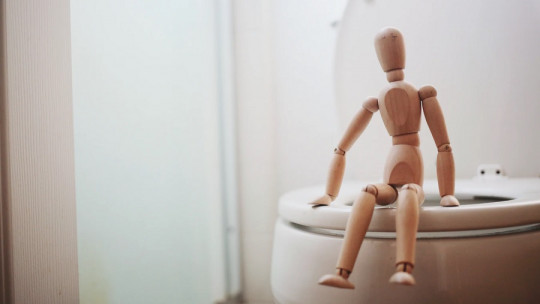
Pelvic floor dyssynergia (or defecatory dyssynergia) is a pathology that responds to an alteration in muscular coordination.in this case, a lack of synchronization between abdominal contractions and anal sphincter function.
This disease accounts for approximately half of the cases of chronic constipation, and therefore, knowing its causes and treatments is essential for anyone who has irregularities when going to the bathroom. Here we show you everything you need to know about her.
Pelvic floor dyssynergia: a functional disorder
To understand the origin and treatment of pelvic floor dyssynergia, it is necessary to talk about chronic constipation and its clinical manifestations first.
About constipation and its figures
According to various medical portals, Constipation is defined as a process based on scant defecation, three times a week or less, difficulty emptying the intestinehard and bulky stools or sensation of intestinal impaction.
These signs may also be accompanied by gas, bloating, and stomach cramps. In Spain, functional chronic constipation disorders can affect 14 to 30% of the population, depending on the demographic sector we look at.
Even so, it is essential to clarify that There are four different types of chronic constipation:
In addition to the classification stated above, The types of constipation can be classified as anatomical (due to structural alterations of the body) or functional. (anisms, that is, due to motor incoordination).
All this terminology and percentages help us to classify pelvic floor dyssynergia more quickly, since it is a pathology of chronic functional constipation of the pelvic floor, which affects 10 to almost 20% of the general population. It is a non-organic acquired behavioral defect, that is, it is not present at birth and does not respond to an anatomical abnormality. Like many other pathologies, you could say that this one comes “from the head.”
Causes
Pelvic floor dyssynergia is widely correlated with common factors in the life of any adult, such as stress and anxiety.
In addition, there are other intrinsic factors of the person themselves that can promote the appearance of chronic constipation, such as gender (women are more prone to it) or ethnicity. Other parameters such as inadequate diet, lack of exercise, aging, low socioeconomic status or depression favor intestinal disorders.
Anxiety and stress are also linked to many other gastrointestinal processes, as they have been shown to generate an imbalance in the normal intestinal microbiota (commensalistic bacteria), thus favoring the appearance of gas, colic and other clinical manifestations. These emotional disorders so common in a busy society also manifest themselves in other ways, such as increased heart rate, rapid breathing, tremors and excessive sweating.
Due to all these clinical manifestations (which include defecatory dyssynergia), as well as the negative emotional effect it has on those who suffer from them, seeking psychological help in the face of generalized stress and anxiety becomes essential.
Symptoms
Pelvic floor dyssynergia is characterized by symptoms shared with many other intestinal disorders. This is, the feeling of incomplete evacuation and repeated defecatory efforts over time among many other discomfortsalready mentioned previously.
Diagnosis
The diagnosis of this pathology is very specific, since to find it, dysfunctions of anatomical or metabolic origin must first be ruled out (such as diabetes) or constipation derived from the application of drugs or drug consumption. To do this, a series of specific steps are followed that we show you below.
1. Physical examination
First of all, it is necessary to perform a rectal inspection and examination, since This way pathologies of structural origin are ruled out. Furthermore, this touch is highly sensitive for diagnosing pelvic floor dyssynergia, as it also allows assessing the pressure of the anal muscles both at rest and during exertion.
It may also be necessary to ask the patient to keep a “defecatory diary”, recording various parameters when going to the bathroom for 15 to 30 days (use of laxatives, evacuation effort… etc.)
2. Ball expulsion test
As strange as it may seem, this diagnostic method is based on the rectal introduction of a probe with an inflated balloon at its end into the patient. This You must make defecatory efforts such as those that would occur during a normal evacuation, and, in general, if it takes more than a minute to expel it, it may be a sign of dyssynergia. This test has demonstrated stellar detection utility, as it allows for clear diagnosis support in up to 97% of cases.
3. Anorectal manometry
This technique consists of measuring pressures inside the anus and rectum, both at rest and during continence or defecation. It’s based on the placement of a probe, about 10 centimeters deep in the rectum, which allows the measurement of various parameterssuch as:
4. Defecography
This last detection method, in this case non-invasive, is based on the use of specialized magnetic resonance machinery, which provides images of the different defecatory stages of the individual. This allows you to evaluate how well the pelvic muscles are working and to provide information about rectal function.
All these diagnostic tests, as we have seen, are intended to rule out structural physiological anomalies and test the motility of the patient’s rectal muscles.
Treatment
Biofeedback is the treatment of choice for pelvic floor dyssynergiaand is based on carrying out a series of 30-minute outpatient sessions for one or two weeks.
Through the use of manometry probes and other methods, the aim is for the patient to gain awareness of their own rectal muscles, which promotes greater self-control over their sphincter muscle function and motor coordination. The effectiveness of this technique is up to 80% of cases.
Other accompanying factors that can promote the disappearance of this rectal muscle anomaly may be routine exercise, a diet rich in fiber and fluids, and the use of laxatives in the initial moments after diagnosis. It goes without saying that psychologically and routinely tackling anxiety and stress disorders, if they occur, will also be essential to address the pathology.
Summary
As we have seen, defecatory dyssynergia is a pathology that does not respond to physiological or anatomical disorders, such as anal fissures, hemorrhoids, etc. It is a disease widely linked to the patient’s emotional and mental health.because as we have already said previously, it is linked to situations of anxiety, stress and depression.
The diagnostic methods that lead to the detection of this disease are varied and complex, since first of all, any other disease linked to metabolic or physical processes must be ruled out.








